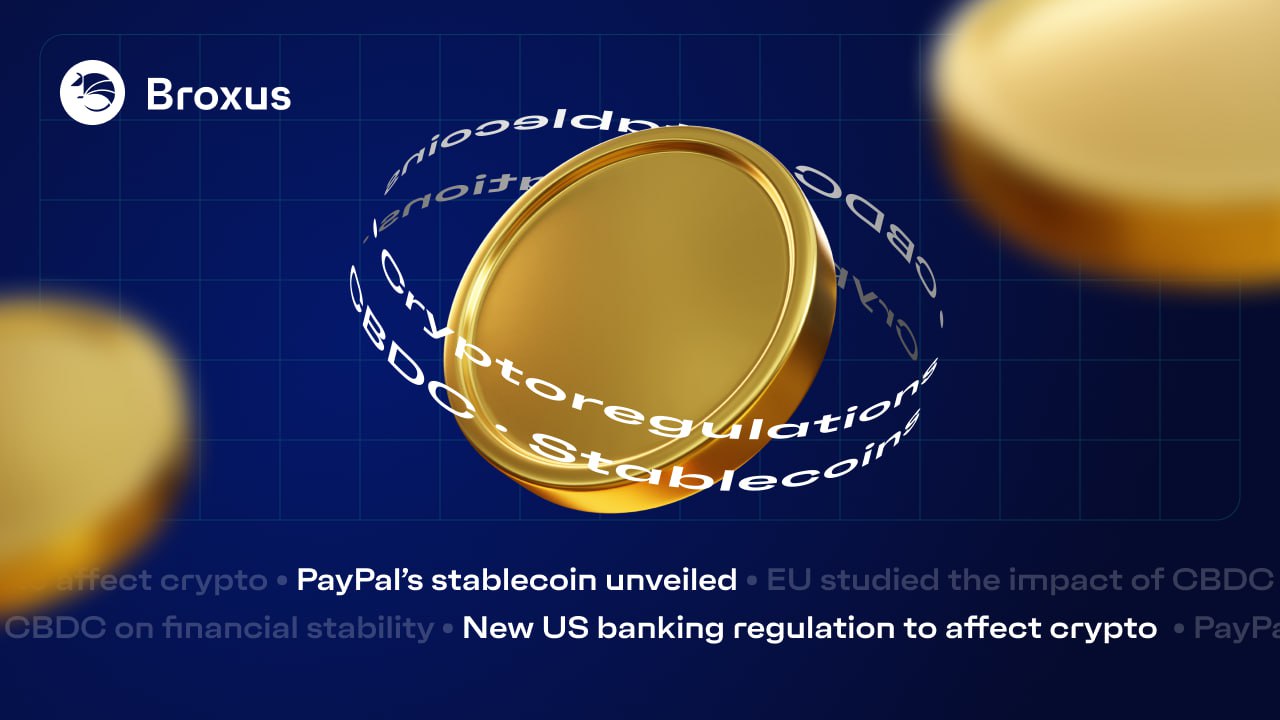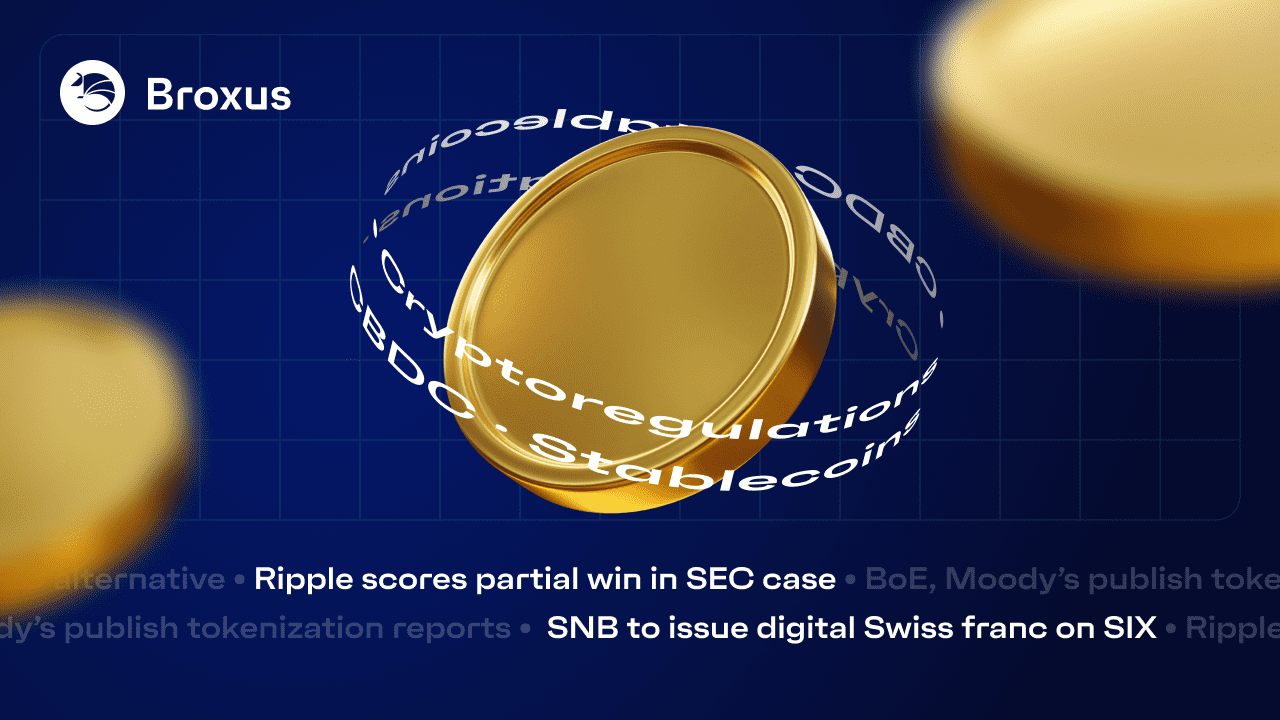The Latest from the World of CBDCs
Atakan Kavuklu’s latest Medium post has provided an overview of the current status of central bank digital currency (CBDC) projects around the world as of July 2023 and there have also been updates made to https://cbdctracker.org. Mention must be made of the integration of e-CNY with NFC devices, which should facilitate access to digital currency for the elderly, as well as the latest statistics on the volume of the yuan, which reached 1.8T yuan payments or $249.33bn. Swaziland has confirmed that it has chosen the Giesecke solution +Devrient (G+D) Filia for its national digital currency, and Nigeria is trying to save its project with NFC stickers for devices that cannot work with the eNaira wallet.
The Bank of Korea (BOK), in its 2022 Payments and Settlement Systems Report, provided an update on the work it has been doing to create trial CBDC concepts. Specifically, the bank has been studying smart contracts, offline payments using NFC and cross-border payments. In addition, BOK connected 14 banks to its CBDC simulation system to test how it works in the regions of Jeju, Busan and Incheon. It processed 2 thousand transactions per second but once it reached its design capacity, it slowed down.
The Bank of Canada has published a paper saying that most Canadian adults have access to a variety of payment methods, and this is likely to continue in a cashless environment. However, some people may find it difficult to make payments if merchants stop accepting cash. This suggests that addressing the unmet payment needs of a minority of consumers by issuing digital currency could be challenging.
The Bank of the Netherlands released a paper on a similar topic. The study was focused on people with low levels of digital literacy, disabilities or financial difficulties. Based on the comprehensive payment data, it turned out that for many of them, cash is an important means of payment. 7% said that they always use cash at points of sale, and 28% indicated that they cannot do without cash.
In the EU, the Center for Economic Policy Research (CEPR) published a paper arguing that, given the limited private incentives to adopt digital euros, an aggressive marketing and product development strategy should be pursued. However, such an aggressive approach is unlikely to be implemented, as it is contrary to the implicit goal of the European Central Bank – to protect the existing business model of banks. The authors argue that the advent of retail CBDCs provides an opportunity to rethink the current monetary architecture and reassess the financial stability risks associated with private money creation and fractional reserve banking. The authors also drew attention to the work of Burlon et al. (2022), which shows that since the idea of the digital euro entered the dialogue in October 2020, the share prices of banks more dependent on deposit financing suffered losses compared to the shares of competitors who are less dependent on deposits, but this difference began to disappear after plans for holding limits and negative premiums were publicized.
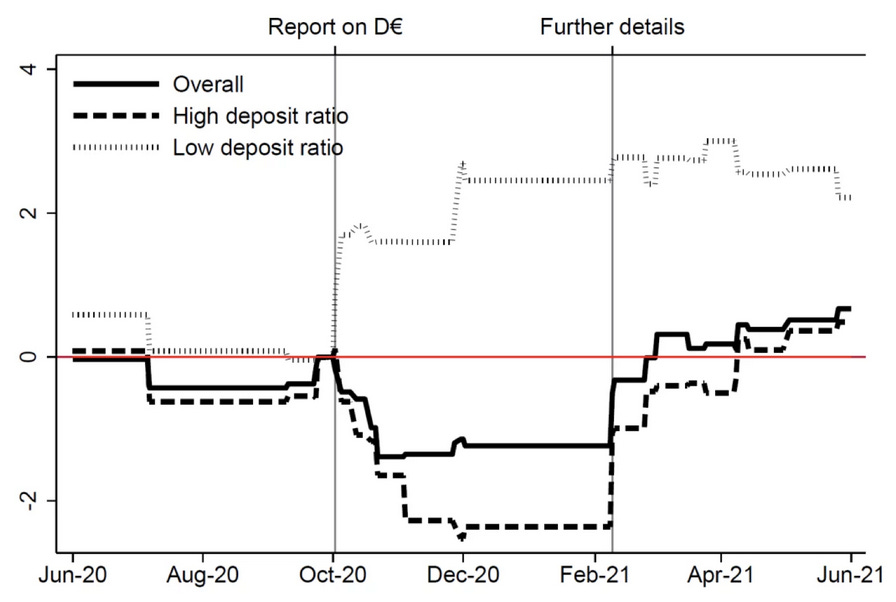
On the chart above, each horizontal bar shows the cumulative abnormal returns up to the last key event relative to the level as of October 1, 2020. The two gray vertical lines indicate the publication of the ECB Digital Euro Report on October 2, 2020, and an interview on the subject that was published on February 9, 2021.
Japanese firm Soramitsu will try to connect Japanese businesses with Cambodia, where the Bakong project is already operating. The idea is to link Japan to the Cambodian Bakong with a Japanese stablecoin through an FX coin exchange. Once actuated, Bakong would become an intermediate hub for these payments to Japan. Bakong is already making cross-border payments using QR codes with Malaysia, Thailand and Vietnam.
The Digital Dollar Project has conducted an experiment with cross-border payments involving The Western Union Company (Western Union), BDO Unibank, Inc. (BDO Unibank) in the Philippines, and Accenture. And its rival, Project Hamilton, has published its platform code for smart contracts.
The Reserve Bank of Zimbabwe has reported that it has entered an advanced stage of launching gold-backed tokens for transactional activity. Chairman Mangudya also said that key stakeholders such as the Confederation of Zimbabwe Industries (CZI) have committed to issuing GBDT-denominated cards.
The Bank of Brazil and the Bank of Russia have created logos for their digital currencies and the Central Bank of the Russian Federation already started pilot testing on August 15, 2023. The pilot will include 13 banks and a limited number of their clients. In the first phase, basic transactions will be verified, including account opening and transfers, person-to-person transfers, simple automatic account payments and payments using QR codes. Participants will be able to make payments in digital rubles at 30 outlets located in 11 Russian cities. With the successful completion of phased testing, digital rubles will be introduced into wide circulation in 2025. Meanwhile, survey results show that only 13% of consumers will use the digital ruble, the rest of the participants either do not understand how it will work or do not see the point in using it.
Ripple has released more details on the US dollar-backed Palau Stablecoin (PSC) prototype, which should serve as a CBDC currency for that island country. Each PSC will be valued at one US dollar guaranteed by a 1:1 fiat reserve and issued on the XRP Ledger (XRPL). The Palauan Ministry of Finance (MOF) will oversee the system and initiate the issuance and redemption of stablecoin units while guaranteeing a 1:1 reserve. The PoC will be rolled out in phases, with approximately 200 government officials and local merchants participating in the first three-month phase.
The Reserve Bank of India (RBI) and the Central Bank of the United Arab Emirates (CBUAE) have agreed to establish a framework to promote the use of the Indian rupee (INR) and the UAE dirham (AED) in cross-border transactions, as well as to interweave their fast payment systems (FPS) in order to reduce the cost of transactions by not having to convert dollars. Specifically, they will link the Indian Unified Payments Interface (UPI) with the UAE’s Instant Payment Platform (IPP), as well as link their card switches (RuPay switch and UAESWITCH).
Stablecoins
The story of the month is PayPal, which, together with Paxos, released PYUSD, a new stablecoin, which, judging by the contract code, does not differ much from the company’s practices: money can be frozen and then “deleted”. The company has even announced ambitions to issue a central bank digital currency.
The recently closed Binance stablecoin BUSD was also backed by Paxos. PayPal, as a payment company, is touting its new stablecoin primarily for shopping and moving money — transferring PYUSD to external wallets, sending to other people, financing purchases and converting to other cryptocurrencies. It’s still early, but we haven’t seen any exchange integration announcements. Although the technical integration of the ERC-20 token on the exchange is quite simple, in order for PYUSD to become actively used in trading, it is necessary to create markets.
Tether (USDT) has been dominating the market and this has given rise to a discussion about the decline of their main competitor USD Coin (USDC), in particular how it coincides with the hypothesis of Gresham’s law: USDC is more convenient and it is easier to get fiat to a bank account with it, so it is better and disappears from circulation. There are also opposite points of view: USDT is better because it remains outside of US regulations and therefore people prefer it. Analytically, it is not easy to apply Gresham’s law to two stablecoins tied to the same fiat asset; one of them would have to have a price discount or premium.

As reported by Forklog, US House of Representative Maxine Waters expressed “deep concern” about the launch of PayPal’s stablecoin, pointing to the absence of a regulatory framework for such assets. “PayPal, with 435 million customers globally, exceeds the number of online accounts at all of the megabanks combined. Given PayPal’s size and reach, Federal oversight and enforcement of its stablecoin operations is essential in order to guarantee consumer protections and alleviate financial stability concerns,” the congresswoman said.
Similar opinions were expressed when Facebook tried to launch a stablecoin – millions were spent on the Libra project, but it could not overcome the force of regulatory gravity. Before Facebook, Pavel Durov had ambitious plans to build a stablecoin inside his Telegram messenger app, but the project was also closed by the SEC. The PayPal stablecoin is another attempt, which is also being undertaken during a bear market and with active opposition from regulators. Immediately after the news about the launch of PYUSD, a press release from the Fed followed, which warned banks about the necessity of additional procedures when starting work with stablecoins. On the market side PayPal tries to enter hyper competitive field with single dominating player, nearly monopolist.
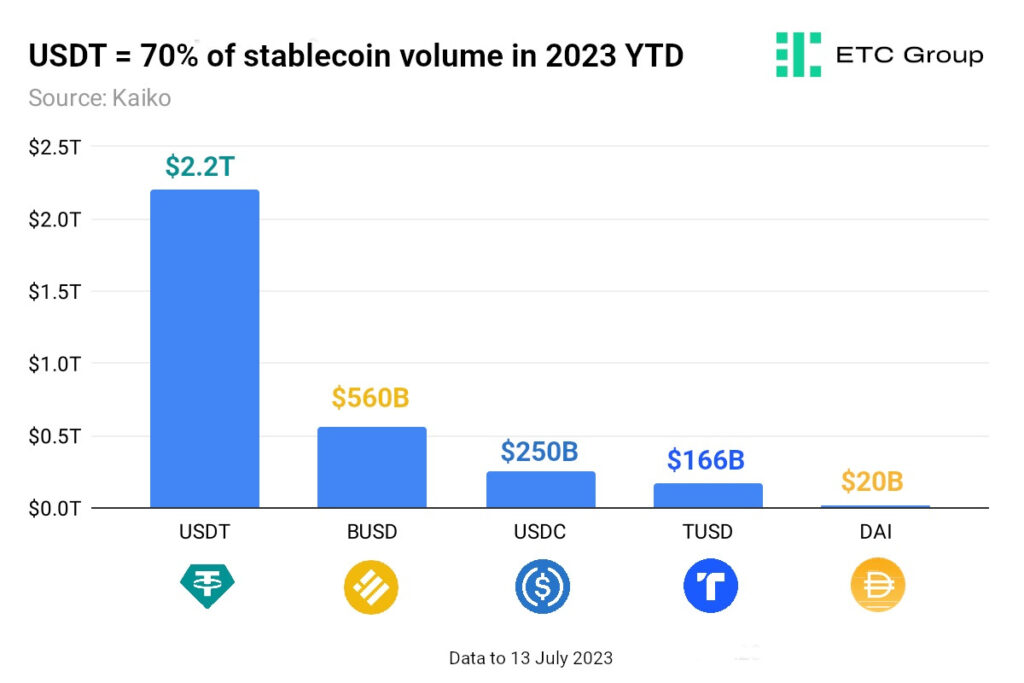
Coinmetrics has also published a small quantitative study on stablecoins. Here we present statistics on regional volumes. USDC volumes in general have shrunk, but prior to the FTX crash, the US was the leader in transactions in these stablecoins.
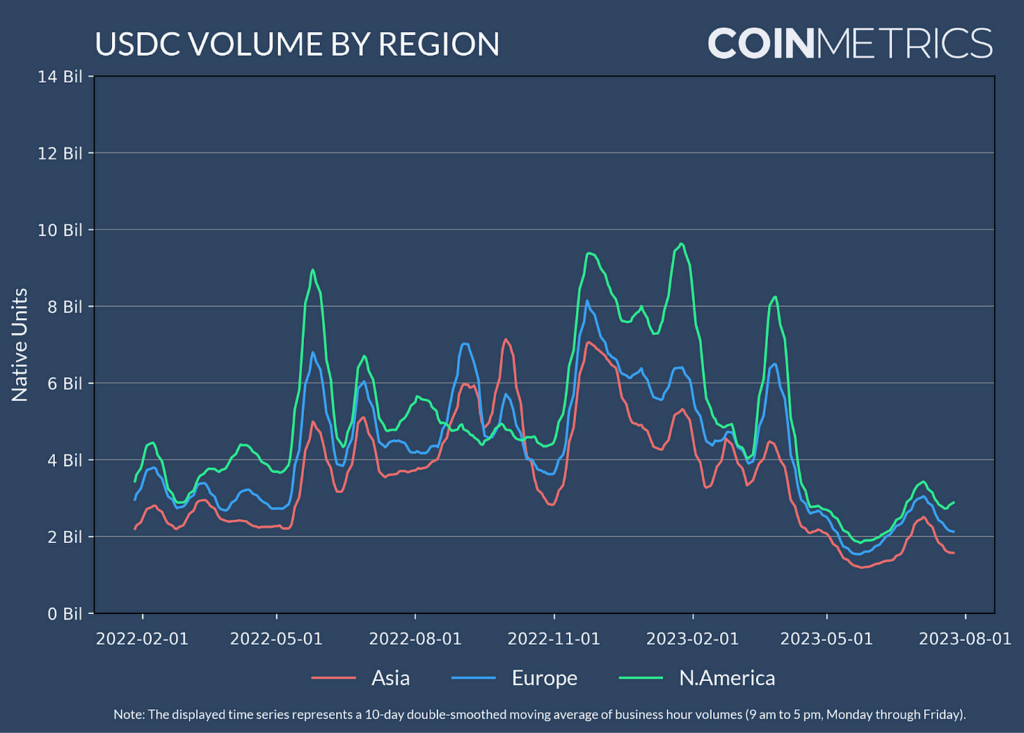
After the crash, Asia and Europe as a whole restored the previous trend, while the US stock market has had about the same turnover.
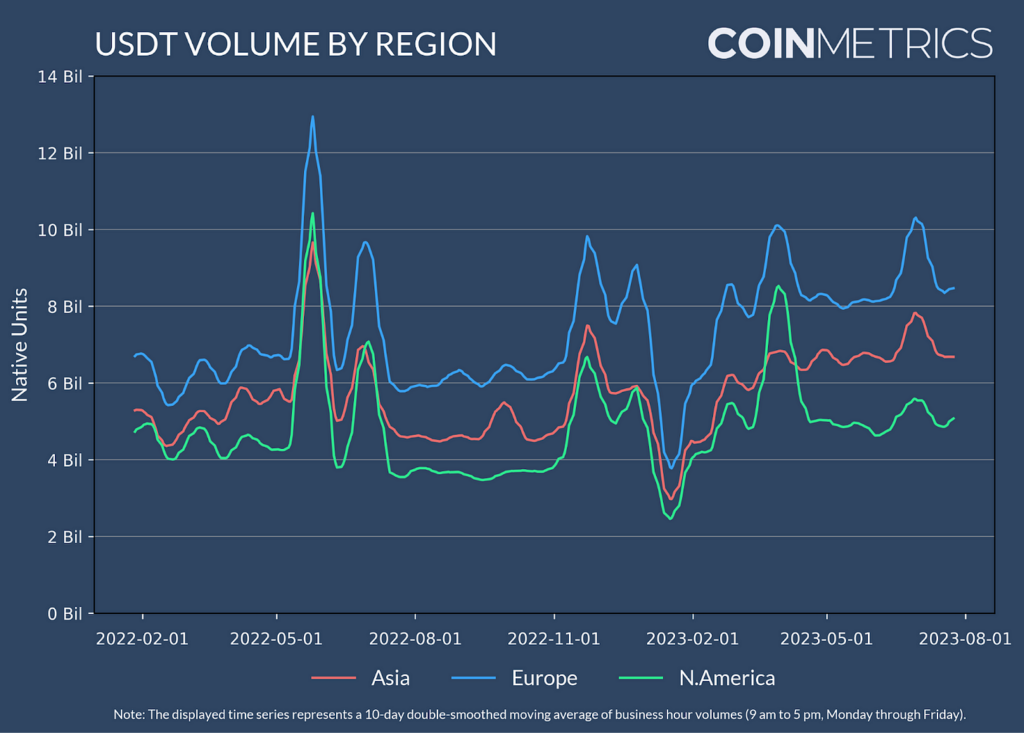
Tokenization
Grayscale and a number of other companies have filed or renewed applications for Ethereum futures ETFs. A total of 6 applications for new funds have been opened:

The Digital Euro Association is considering the option of tokenizing deposits in banks. This implies the likely mechanics of paying income on deposits and combinations of tokens with digital currencies that mimic cash without interest.
Tel Aviv Exchange TASE will use Fireblocks services to store digital assets. NASDAQ, on the other hand, has curtailed plans to provide token storage services.
Regulations
Singapore regulators have defined the rules for stablecoins. According to representatives of MAS, potential issuers will have to meet several key requirements. These include the need to maintain appropriate reserve assets to ensure stability, the requirement to maintain a minimum capital base and liquid assets, the possibility of returning the nominal value of stablecoins to holders within five business days after a redemption request and disclosure requirements. MAS has also launched a $150 million fintech fund, clearly signifying that the development of the sector is trending upwards in Singapore.
The US Federal Reserve has published additional information about its program to supervise the new activities of the banks it watches over. These new activities include sophisticated technological partnerships with non-banks to provide banking services to clients, as well as activities related to crypto assets and blockchain. The Fed also provided additional information on the process that Fed-supervised state banks must follow before engaging in certain dollar token or stablecoin activities, including demonstrating to Fed supervisors that appropriate safeguards are in place to conduct such activities safely and securely. The press release was released just after the PayPal announcement. The new regulations will make it difficult for banks to operate in the crypto industry, as the SEC also requires an excessive amount of reporting, which almost led to the closure of Silvergate in December 2022.
